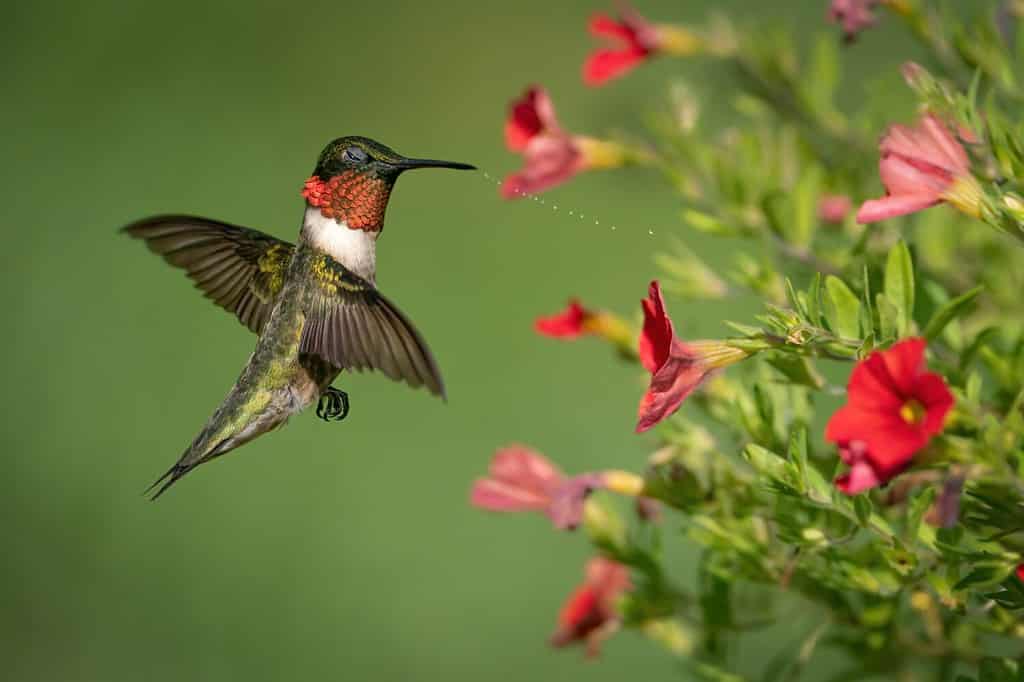Hummingbirds, whose scientific name (and family name) is Trochilidae, belong to the kingdoms Animalia and Phylum Chordata. These tiny birds are known for being top pollinators. They’re called “hummingbirds” because of the humming sound they make when they flap their wings quickly. They’re also the only bird that can fly backward.
While their prey includes ants, spiders, beetles, mosquitos, gnats, weevils, fruit flies, and aphids, nectar is their main source of food. Nectar is easy to make, and many bird lovers will create their own hummingbird nectar to attract hummingbirds to their yards. This is actually important for hummingbirds, as they have high metabolisms that require them to every 10 to 15 minutes.
This article will teach you how to easily make hummingbird food at home.
What Is Hummingbird Nectar?
Hummingbird nectar is made up of sugar and water. The birds can find natural nectar from flowers or broken fruit, as they both provide a source of sugar. However, they rely on humans for much of their diet. Making homemade hummingbird nectar is easy and can attract these beautiful, tiny birds to your home.
Thankfully, hummingbirds aren’t picky, so you don’t even have to perfect your hummingbird nectar recipe. So long as you provide sugar, they’ll consume the food.

On average, hummingbirds flap their wings 10-15 times per second.
©Cavan-Images/Shutterstock.com
How to Make Hummingbird Food
Making hummingbird food is easy. Follow the directions below for a seamless process.
Ingredients
As stated above, hummingbird nectar consists of just sugar and water. However, not all sugar will work. When creating this mixture, use only refined white sugar. Never use honey, corn syrup, raw, unprocessed sugars, or powdered sugar, as they might contain additional harmful ingredients. Additionally, many will add food coloring to the mixture, but this is actually unsafe for hummingbirds.
In terms of water, you can use tap water as part of your nectar mixture. You don’t need to boil it or prepare it any specific way.
Step-By-Step Directions
To create your hummingbird nectar, follow these directions.
- Gather your ingredients: Collect your water and your white sugar, following the recipe of one part sugar and four parts water. Depending on the amount of nectar you want to make, one “part” might equal different measurements. For example, if you want to create a large batch, you might use two cups for one part, so you’d mix two cups of sugar and eight cups of water.
- Mix your ingredients together: Mix the water and sugar until the sugar has dissolved. You can do this by shaking the mixture together or simply stirring it with a spoon.
- Fill your hummingbird feeders: Once you’ve created your mixture, fill your feeders with the nectar to attract and feed hummingbirds. Be sure to clean your feeder every other day, especially during hot weeks.
- Store extra nectar properly: You can store your hummingbird nectar in the fridge for up to a week. Just ensure there’s no mold growing on the mixture, as this can be harmful for hummingbirds to consume.
FAQs about Hummingbird Nectar
How Often Should I Change the Sugar Water in my Hummingbird Feeder?
As noted above, you should change the hummingbird nectar in your feeder every other day, especially if it’s hot outside. Additionally, check for mold and completely clean out the filler if there is any sign of it.

A hummingbird feeder with sugar water will attract hummingbirds and supplement the nectar they gather.
©Rick Scuteri/Shutterstock.com
When Should I Set up my Feeder?
Many believe there are wrong times to set up hummingbird feeders, claiming it will deter them from migrating. However, this isn’t true. Hummingbirds have an internal clock that tells them when to migrate, and setting up a feeder in your yard will not keep them from doing so. In other words, it won’t hurt to leave your feeder up year-round. But, depending on your location, you might not get any visitors during certain months.
If you live in southern or warmer parts of the U.S., you’ll likely see hummingbirds on your feeder from mid-February all the way through November. In the middle regions of the U.S., you can count on April through October, and in the Northern parts, May through September.
Where Should I Set up my Feeder?
Since hummingbirds are constantly on the go and exerting energy, they like to feed in areas that provide them a sanctuary. Set up your feeders about 10 to 15 feet from a tree or shady place where they can rest and feed out of the direct sunlight. This will also preserve the sugar water.
Many homeowners will place a hummingbird feeder right by their house, especially near a window, so they can observe the cute creatures as they eat. You can hang your feeder from a gutter or awning; however, it should be no closer than 15 feet from windows so the birds don’t accidentally fly into the glass.
The photo featured at the top of this post is © Jeff Westhead/Shutterstock.com
Thank you for reading! Have some feedback for us? Contact the AZ Animals editorial team.







